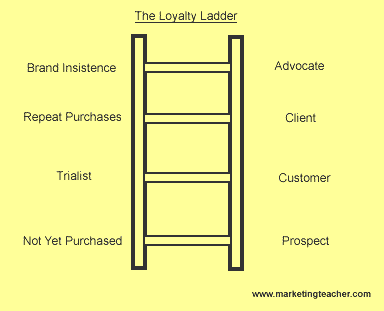The Loyalty Ladder
Turning a prospect into an advocate
The loyalty ladder is a tool for marketing communicators. The idea is that consumers can be moved along a continuum of loyalty using a number of integrated marketing communications techniques (it is also referred to as a branding ladder).
Example – Tesco PLC.
In the United Kingdom Tesco plc is by far the most successful company in regard to relationship marketing. There are number of reasons for this which would include loyalty programmes, consistently adding value at every customer touch point, and making it difficult for customers to actually end the relationship. Let’s have a look at an example of each. The Tesco loyalty scheme or loyalty program is called the Tesco Clubcard. The card is scanned every time that there is a transaction. So data is ‘grabbed’ and recorded from each customer. Here we have a highly developed customer database. Customers are sent coupons which are strongly connected to their buying habits, based upon Tesco’s knowledge of other customers. As you leave the till after payment you are given money-off coupons for petrol so that you can fill your car when you leave for home. This consistently adds value to your experience as a customer. Since a British consumer now heads for a Tesco village to do his/her weekly shopping, it is difficult to swap to another store or to go back to shopping in smaller shops. The relationship is difficult to break.
Essentially, consumers become loyal to a brand which has meaning to them in relation to a product, service, solution or experience.
As with continuums of behaviour such as UACCA – Unawareness, Awareness, Comprehension, Conviction, Action, or AIDA – Awareness, Interest, Desire, Action, the loyalty ladder begins from a point where the consumer has Not Yet Purchased, then he or she buys the product for the first time (Trialist), if the trial has been a success he or she returns to buy again and again (Repeat Purchaser) and finally the consumer buys no other brand (Brand Insistent).

At the Not Yet Purchased Stage the consumer is merely a Prospect. As he or she trials they become a Customer. The Repeat Purchaser is a Client since he or she is becoming loyal. Finally, the consumer becomes an Advocate (i.e. activist or campaigner) since he or she is Brand Insistent. At this point the brand is difficult to dislodge since it has so much meaning to the consumer. Great brands such as Nike, BMW, Rolls-Royce, and Apple are in this highly desirable position.
The idea is to move your prospect along the loyalty ladder to the point where there are partner. Marketing activities support relationships with external customers. So there will be directly indications and measurement of the results between the marketer and the customer as he or she moves along the loyalty ladder. Both the loyalty ladder and the Pareto principle are useful because they aid customer retention and loyalty.
